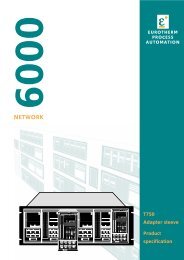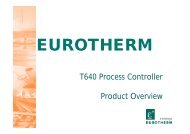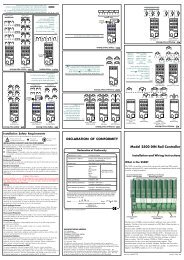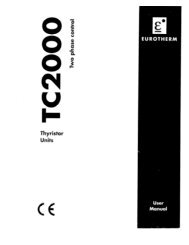MODEL 2604 CONTROLLER - USER GUIDE - d a n m a r k
MODEL 2604 CONTROLLER - USER GUIDE - d a n m a r k
MODEL 2604 CONTROLLER - USER GUIDE - d a n m a r k
Create successful ePaper yourself
Turn your PDF publications into a flip-book with our unique Google optimized e-Paper software.
RESEARCHLETTERaReference beamHOEabObjective beamLens arrayPhotorefractivedevicebcFigure 5 | Telepresence system. a, Picture of a hologram recorded with the 3Dtelepresence system. Supplementary Movie 2 shows the recording and thedisplay of the telepresence hologram. b, Picture of a functional prototype of a12 inch 3 12 inch photorefractive device, held by W.-Y.H. Images of M.Y.(a) and W.-Y.H. (b) are used with permission.dFigure 4 | Full parallax recording sketch. a, The lens array focuses the objectbeam onto the photorefractive device. The reference beam is redirected andfocused by the HOE so that the lens array collimates the reference beams andthey intersect the object beams in the plane of the device. b–e, Variousperspectives of a full parallax hologram representing a castle and towers.Recording was done by simultaneously writing 100 hogels; perspectives arerespectively up right (b), up left (c), down right (d) and down left (e).respect to the direction of the external field vector do not produce ahologram. The combination of both principles allows the use of threeindependent pairs of recording beams for the red-green-blue colours.Our photorefractive polymers are mostly transparent in the visibleregion of the spectrum, allowing us to effectively reproduce full colourin the transmission geometry. We have recorded colour hologramsreproducing vivid colours, as shown in Fig. 3. The colour reproductionof the hologram can be changed according to the reading light sourcesused. The diffraction efficiency for each hologram is 0.5%, which islarge enough to be viewed under ambient light conditions.As perspective is mostly provided to human vision through the eyes’horizontal separation, HPO is acceptable for most 3D applications.However, full parallax is required for even better rendering or for somespecific applications, such as tabletop displays that can be observedfrom all positions. The challenge of full parallax derives from thenumber of hogels to be recorded, namely the square of that needed inHPO. For example, for a 4 inch 3 4 inch screen and 1-mm resolution,eHPO requires 100 hogels whereas full parallax requires 10,000 hogels.Even with the pulsed laser system we introduce here, the recording timebecomes more than 3 min for full parallax.To overcome this limitation, we used a lens array together with aholographic optical element to spatially multiplex the recording beams.A sketch of the optical system is presented in Fig. 4a. The focal distanceand the diffraction angle of the HOE were carefully designed to matchthe lens array focal length and lens separation so the reference beams arecollimated. By using this system, we demonstrated the simultaneousrecording of 100 hogels with a single pulse (Fig. 4b), decreasing therecording time by the same factor. A raster scan driven by high-speedtranslation stages was used to cover the entire area of the photorefractivedevice. The surface area illuminated with the multiplexing setup ina single exposure (1 cm 2 ) is the same as in the HPO geometry (1 mm3 10 cm 5 1cm 2 ), but the spatial distribution is different (multiplesquares instead of a line). Thus, the same laser source with an identicalpower can be used to obtain equivalent diffraction efficiency. Figure 4cshows resulting image obtained by this full parallax system.Holographic cinematography has previously been demonstrated 24 ,but the need to process the recording media after exposure (using silverhalides or photopolymer) prevents real-time operation and creates alarge delay between recording and replay. With the new photorefractivepolymer we describe here, quasi-real-time recording and replayingis achieved. Hogel generation in holographic stereography can be performedat video rate and does not require much computational power,as opposed to computer-generated holograms. The real-time recordingand viewing, together with the lack of a requirement for extensivecomputational power, opens the door to new applications, including3D telepresence—as we now demonstrate.Our 3D telepresence set-up consists of 16 Firewire cameras that takesimultaneous pictures of a real 3D scene every second. The 16 views areprocessed into hogel data by the host computer, and sent to the holographicrecording controller through a 100 Mbit s 21 Ethernet link thatis used at less than 10% of its capacity. For a 4 inch 3 4 inch display,120 hogels are processed for HPO conditions and sent every secondusing a general-purpose desktop PC. The pulsed holographic recordingset-up is used to continuously write the hologram according to theflow of data, so that the 3D images are refreshed continuously. Once ahologram has been written, the system uses the next available hogels toupdate the information.The hologram is read by light from a colour LED incident at theBragg angle. The advantage of the holographic transmission geometrywe are using is that the viewer is able to see the hologram all the time, asreading and writing occur simultaneously. The writing beams are onthe opposite side of the screen with respect to the diffracted read outlight; the writing beams are therefore blocked from the viewer, which is82 | NATURE | VOL 468 | 4 NOVEMBER 2010Macmillan Publishers Limited. All rights reserved©2010






